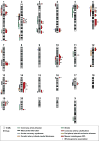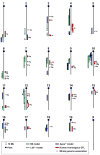Genetic and genomic insights into the molecular basis of atherosclerosis
- PMID: 17767904
- PMCID: PMC2083632
- DOI: 10.1016/j.cmet.2007.07.001
Genetic and genomic insights into the molecular basis of atherosclerosis
Abstract
Atherosclerosis is a complex disease involving genetic and environmental risk factors, acting on their own or in synergy. Within the general population, polymorphisms within genes in lipid metabolism, inflammation, and thrombogenesis are probably responsible for the wide range of susceptibility to myocardial infarction, a fatal consequence of atherosclerosis. Genetic linkage studies have been carried out in both humans and mouse models to identify these polymorphisms. Approximately 40 quantitative trait loci for atherosclerotic disease have been found in humans, and approximately 30 in mice. Recently, genome-wide association studies have been used to identify atherosclerosis-susceptibility polymorphisms. Although discovering new atherosclerosis genes through these approaches remains challenging, the pace at which these polymorphisms are being found is accelerating due to rapidly improving bioinformatics resources and biotechnologies. The outcome of these efforts will not only unveil the molecular basis of atherosclerosis but also facilitate the discovery of drug targets and individualized medication against the disease.
Figures


References
-
- Aiello RJ, Bourassa PA, Lindsey S, Weng W, Freeman A, Showell HJ. Leukotriene B4 receptor antagonism reduces monocytic foam cells in mice. Arterioscler Thromb Vasc Biol. 2002;22:443–449. - PubMed
-
- Arnett DK, Baird AE, Barkley RA, Basson CT, Boerwinkle E, Ganesh SK, Herrington DM, Hong Y, Jaquish C, McDermott DA, O'Donnell CJ. Relevance of genetics and genomics for prevention and treatment of cardiovascular disease: a scientific statement from the American Heart Association Council on Epidemiology and Prevention, the Stroke Council, and the Functional Genomics and Translational Biology Interdisciplinary Working Group. Circulation. 2007;115:2878–2901. - PubMed
-
- Bretschger Seidelmann S, De Luca C, Leibel RL, Breslow JL, Tall AR, Welch CL. Quantitative Trait Locus Mapping of Genetic Modifiers of Metabolic Syndrome and Atherosclerosis in Low-Density Lipoprotein Receptor-Deficient Mice. Identification of a Locus for Metabolic Syndrome and Increased Atherosclerosis on Chromosome 4. Arterioscler Thromb Vasc Biol. 2005;25:1–8. - PMC - PubMed
Publication types
MeSH terms
Substances
Grants and funding
LinkOut - more resources
Full Text Sources
Other Literature Sources
Medical
Molecular Biology Databases

